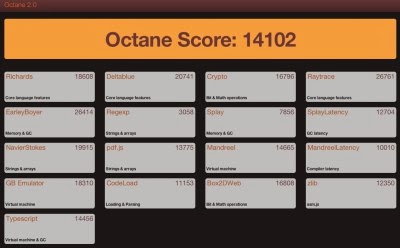GNN Ads
Google debuted version 2.0 of its Octane benchmark suite today, a set of 17 tests that measure how fast a browser can execute JavaScript code.
The first version of this benchmark launched just over a year ago. In this new version, the team put an emphasis on tests that measure latency, but Google also added tests for a number of new JavaScript technologies.
Octane 2.0 now measures how well the browser handles code written or compiled in the Mozilla-backed asm.js JavaScript subset, for example. In addition, Google added a new test based on Microsoft’s TypeScript compiler to measure raw execution speed, code parsing performance and the browser’s memory subsystems.
The addition of asm.js is a pretty interesting move for Google. This project is Mozilla’s attempt to bring JavaScript in the browser to near-native performance and unsurprisingly, Firefox which supports asm.js out of the box since version 22 greatly outperforms Chrome (by about 10,000 to 25,000 on a 2012 Macbook Air).
To measure asm.js performance, Google is using zlib sample code from Mozilla’s Emscripten test suite. While Google itself hasn’t officially shown any interest in supporting asm.js and has instead argued that it would rather make all of JavaScript run as fast as possible, the addition of this benchmark does show that the team is keenly aware of this project and seems to have at least some interest in making asm.js code run as fast as possible in Chrome.
Besides these two additions, Google engineers and “latency buster” Hannes Payer also writes that the team fixed a number of existing benchmarks “to help ensure that they measure what they were intended to.” These include the GameBoy emulator, a regular expressions test, as well as Octane’s CodeLoad, DelataBlue and NavierStokes tests. You can find a complete list of all the tests and their descriptions here.
I haven’t run any formal tests yet, but on my Macbook Air, Firefox 25 and Safari 7.0 score just over 10,000 points, while Chrome 30 scores just over 14,000 (on my Surface Pro, Internet Explorer 11 scores about 8,500 points and Chrome 30 once again gets to around 14,000).
The first version of this benchmark launched just over a year ago. In this new version, the team put an emphasis on tests that measure latency, but Google also added tests for a number of new JavaScript technologies.
Octane 2.0 now measures how well the browser handles code written or compiled in the Mozilla-backed asm.js JavaScript subset, for example. In addition, Google added a new test based on Microsoft’s TypeScript compiler to measure raw execution speed, code parsing performance and the browser’s memory subsystems.
The addition of asm.js is a pretty interesting move for Google. This project is Mozilla’s attempt to bring JavaScript in the browser to near-native performance and unsurprisingly, Firefox which supports asm.js out of the box since version 22 greatly outperforms Chrome (by about 10,000 to 25,000 on a 2012 Macbook Air).
To measure asm.js performance, Google is using zlib sample code from Mozilla’s Emscripten test suite. While Google itself hasn’t officially shown any interest in supporting asm.js and has instead argued that it would rather make all of JavaScript run as fast as possible, the addition of this benchmark does show that the team is keenly aware of this project and seems to have at least some interest in making asm.js code run as fast as possible in Chrome.
Besides these two additions, Google engineers and “latency buster” Hannes Payer also writes that the team fixed a number of existing benchmarks “to help ensure that they measure what they were intended to.” These include the GameBoy emulator, a regular expressions test, as well as Octane’s CodeLoad, DelataBlue and NavierStokes tests. You can find a complete list of all the tests and their descriptions here.
I haven’t run any formal tests yet, but on my Macbook Air, Firefox 25 and Safari 7.0 score just over 10,000 points, while Chrome 30 scores just over 14,000 (on my Surface Pro, Internet Explorer 11 scores about 8,500 points and Chrome 30 once again gets to around 14,000).










